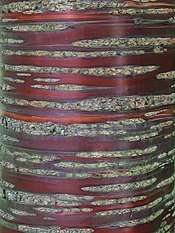Prunus serrula
Prunus serrula, called birch bark cherry, birchbark cherry, paperbark cherry, or Tibetan cherry, is a species of cherry native to China, and is used as an ornamental in many parts of the world for its striking coppery-red bark.
| Prunus serrula | |
|---|---|
| Growth form | |
| Scientific classification | |
| Kingdom: | |
| (unranked): | |
| (unranked): | |
| (unranked): | |
| Order: | |
| Family: | |
| Genus: | |
| Subgenus: | Cerasus |
| Section: | Cerasus |
| Species: | P. serrula |
| Binomial name | |
| Prunus serrula | |
| Synonyms[1] | |
| |
Description

Prunus serrula is a small deciduous tree, often with multiple stems, reaching a height of 20–30 feet (6–9 m). The leaves are arranged alternately, simple, 5–10 cm long and 1.5–2.0 cm broad and a serrate margin.[2] The smooth bark is a brownish red, with prominent horizontal lenticels. The outer layer of the bark is remarkably tough, approaching the strength of Mylar.[3]
Cultivation

Prunus serrula is grown as an ornamental tree, especially for winter interest. It tolerates a variety of soil types and has a wide pH range. It prefers full sun and does well in USDA hardiness zones 5 to 8. Its potential as an invasive species is low, as it is susceptible to many common garden diseases and pests such as fire blight, powdery mildew and Japanese beetles.
It is sometimes grafted to Prunus serrulata (Japanese cherry) crowns, forming a tree with red bark and showier flowers.
In 2012 the 'Branklyn' variety gained the Royal Horticultural Society’s Award of Garden Merit.[5]
References
- The Plant List: A Working List of All Plant Species, retrieved 7 June 2018
- "Prunus serrula". Landscape Plants. Oregon State University. Retrieved 7 June 2018.
- Xu, Xiaoming; Schneider, Edward; Chien, Allen T.; Wudl, Fred (16 September 1997). "Nature's High-Strength Semitransparent Film: The Remarkable Mechanical Properties of Prunus serrula Bark". Chemistry of Materials. 9 (9): 1906–1908. doi:10.1021/cm9701522.
- https://www.rhs.org.uk/plants/14025/Prunus-serrula/Details
- "Prunus serrula 'Branklyn'". Royal Horticultural Society. 2017. Retrieved 28 June 2018.